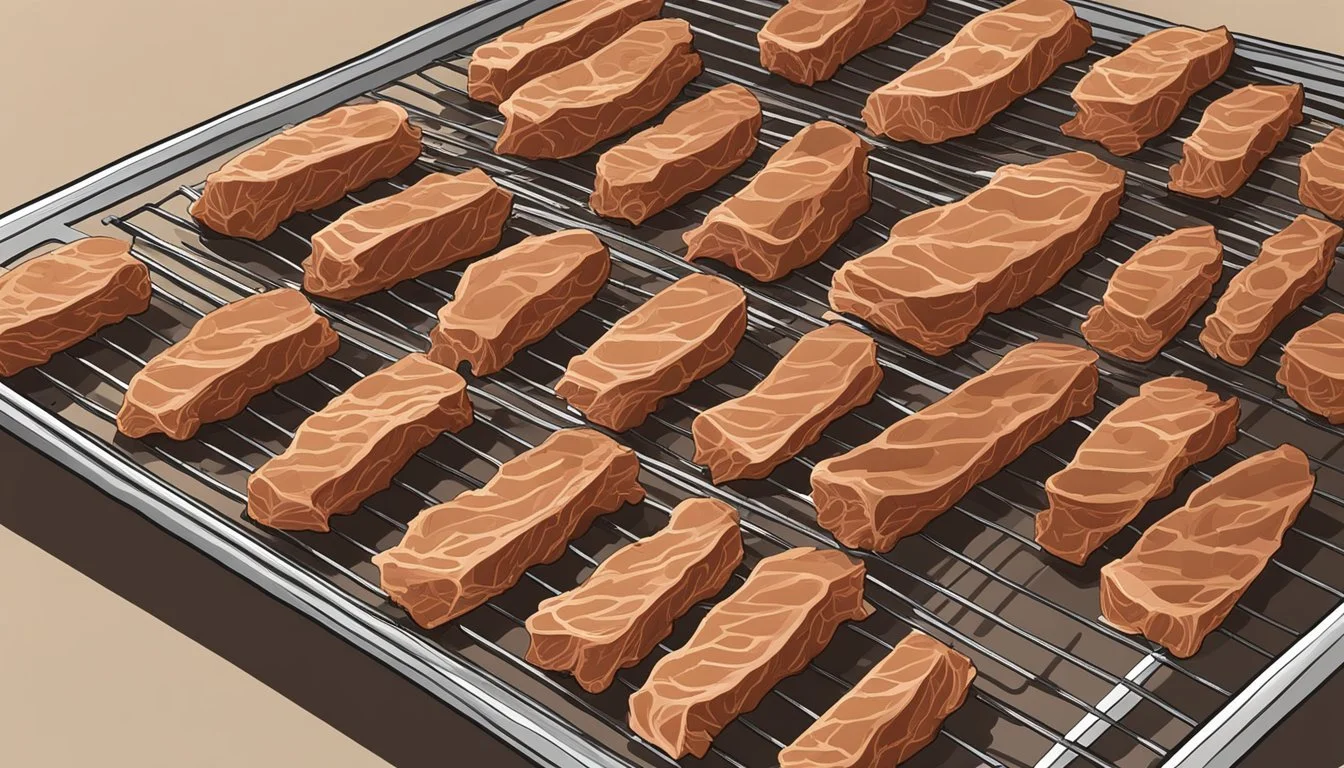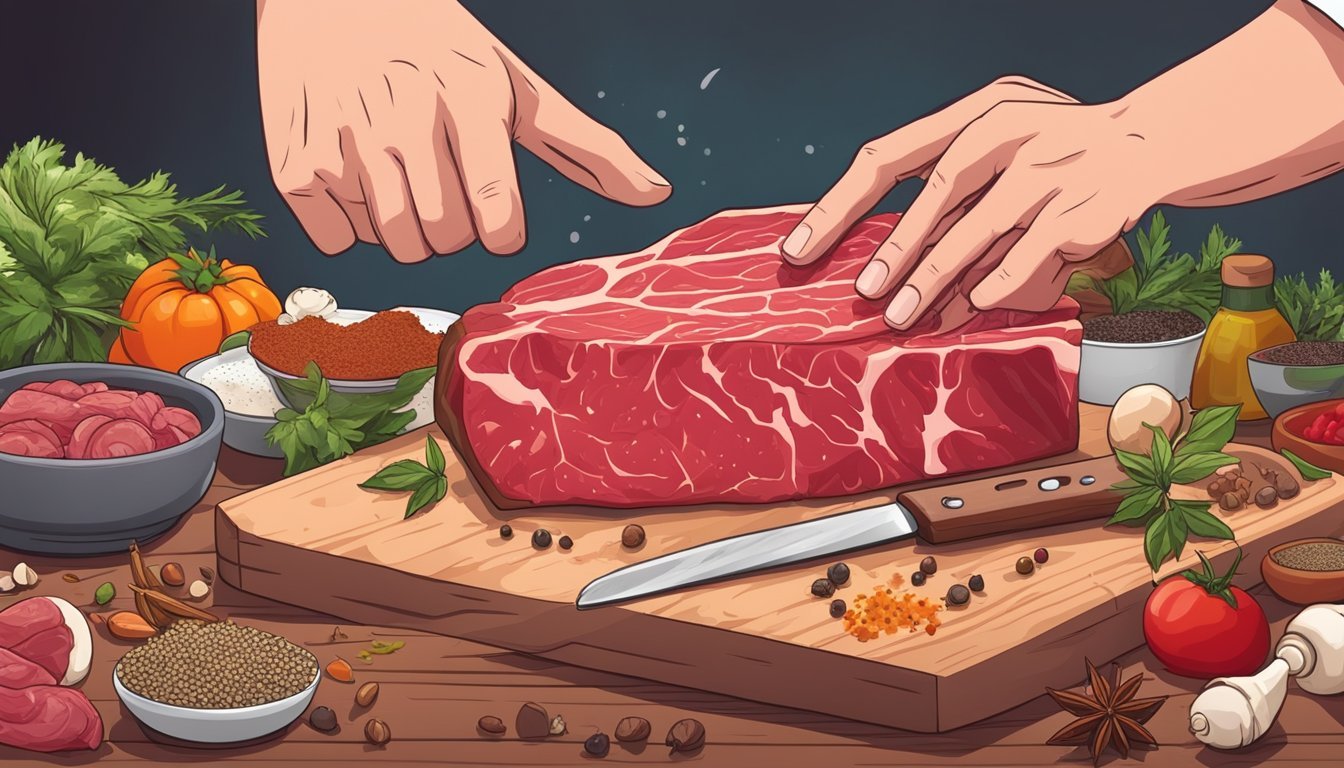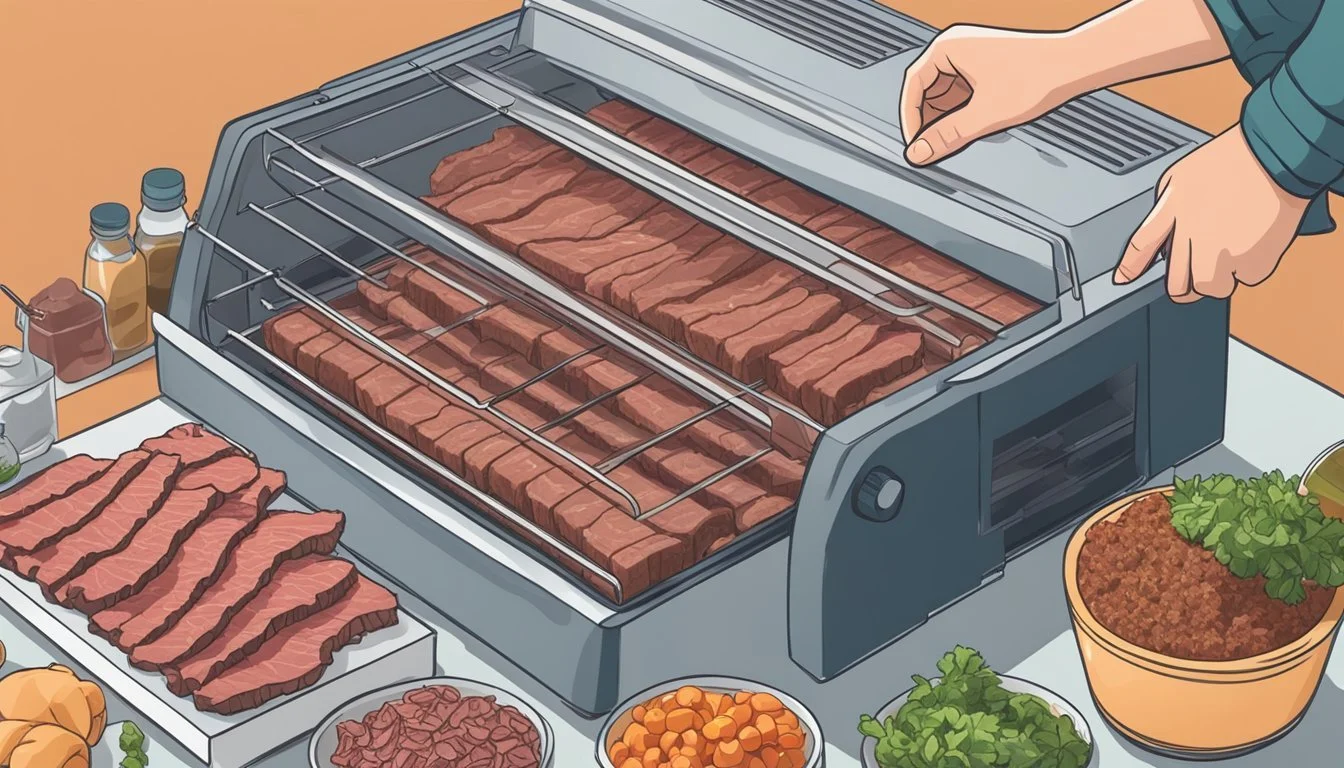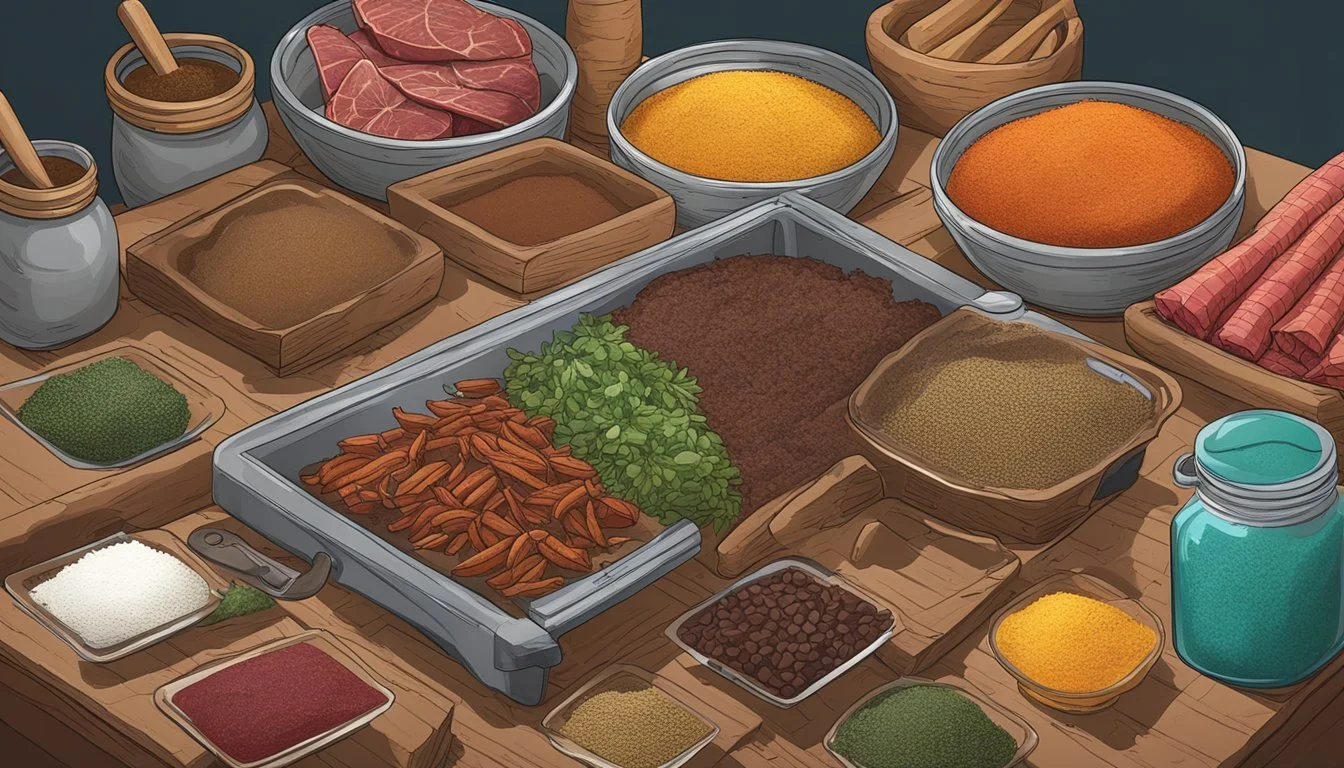DIY Beef Jerky
A Comprehensive How-To Guide for Homemade Snacking Mastery
Making beef (What wine goes well with beef?) jerky at home is a rewarding process that allows for complete control over flavor, texture, and ingredients. A homemade approach to beef jerky not only offers a healthier alternative to store-bought varieties, which are often laden with preservatives and excessive sodium, but it also opens up a world of customization. Whether one prefers their jerky intensely savory, subtly spiced, or with a hint of sweetness, making it at home means they can tailor the flavors to their exact liking.
The method for crafting beef jerky involves selecting the right cuts of meat, crafting a flavor-packed marinade, and determining the optimal drying technique. The process starts with lean cuts such as top round, which has minimal fat that can cause spoilage. Slicing the meat against the grain ensures a tender chew. The meat is then bathed in a marinade - which could be anything from a simple mix of soy sauce and Worcestershire to a complex blend of spices and herbs - and left to soak up the flavors for several hours or overnight.
Drying the jerky is the final critical step, and it can be accomplished using an oven or a dehydrator, depending on preference and equipment availability. Patience is key, as the meat should dry slowly at a low temperature to achieve the perfect leathery, chewy texture. Once dried, storing the jerky properly will maintain its freshness and make sure it's ready to be enjoyed as a protein-packed snack at any time.
Selecting the Right Beef
When making beef jerky, the selection of the right beef is critical. It ensures not only the flavor but also the texture of the final product, with lean cuts offering the best results.
Identifying Lean Cuts
Lean cuts of beef are preferred for jerky as they contain minimal fat, which is crucial for both the preservation and the quality of the jerky. These cuts are typically found from parts of the animal where muscles do more work.
Select lean cuts such as:
Top Round: Often recommended due to its lean nature and uniformity in texture.
Eye of Round: It's the leanest cut and produces excellent jerky.
Sirloin: Offers a nice balance of flavor and leanness.
Bottom Round: Similar to the top round but slightly tougher.
London Broil: A good alternative, but ensure it's trimmed well.
When preparing meat, always slice against the grain. This ensures that the jerky is easier to chew.
Understanding Beef Quality
The quality of beef used for jerky is as important as the cut. High-quality beef will produce a better-tasting jerky. Quality beef can be identified by its appearance and grading.
Quality indicators include:
Color: Look for beef that is bright red in color; it indicates freshness.
Marbling: While lean cuts are necessary, a small amount of marbling can contribute to the flavor without making the jerky greasy.
Grading: USDA grading such as Prime, Choice, or Select can be a reliable indicator of quality, with Prime being the highest.
To make the best jerky, opt for high-quality, lean beef. This level of attention to detail in selecting the right beef will be evident in the taste and texture of the final jerky product.
Preparation Basics
Before making beef jerky, there are essential steps they need to follow to ensure the meat is prepped correctly for dehydrating. Trimming excess fat, slicing the beef properly, and partially freezing for easier cutting are pivotal for excellent results.
Trimming the Fat
They should begin with a lean cut of beef, as fat does not dehydrate well and can cause the jerky to spoil faster. They need to trim off all visible fat meticulously. Excess fat could lead to off flavors and shorten the shelf life of the jerky.
Slicing the Beef
Slicing the beef into consistent, thin strips is crucial for even dehydration and texture. They should slice the meat against the grain. This will make the jerky easier to chew. Strips should be approximately 1/4 inch thick for optimal drying.
Partially Freezing for Easier Slicing
Partially freezing the beef for about one to two hours can simplify the slicing process, making it easier to cut clean and even strips. The meat should be firm but not fully frozen, providing stability for cleaner cuts without the hassle of dealing with overly firm meat.
Crafting the Perfect Marinade
The secret to delicious beef jerky lies in a balance of flavors and proper marination time. This section delves into the specifics of selecting ingredients and determining the ideal marinating duration to infuse the meat with robust flavor.
Exploring Savory Ingredients
For the foundation of a flavorful marinade, one must consider soy sauce and Worcestershire sauce as essential elements. These liquids impart deep umami notes and act as the base for other ingredients to meld together.
Soy Sauce (1 cup): Adds saltiness and depth.
Worcestershire Sauce (1/2 cup): Brings a complex, tangy profile.
Garlic and onion, in their powder form, are pivotal:
Garlic Powder (1 tablespoon): Provides a sharp, aromatic quality.
Onion Powder (1 tablespoon): Offers a milder, yet distinctive flavor.
Black pepper is an indispensable spice for the mix:
Black Pepper (2 teaspoons): Ensures a spicy kick with earthy tones.
Mastering Sweetness and Spice
Balancing the savory with sweet and spicy dimensions creates a moreish jerky. A meticulous selection of sweeteners and spices tailors the profile of the jerky.
Brown Sugar (1/4 cup): Adds sweetness and aids in caramelization.
Conversely, cayenne pepper and red pepper flakes introduce a controlled heat.
Cayenne Pepper (1/2 teaspoon): Delivers a consistent and smooth heat.
Red Pepper Flakes (1 teaspoon): Offers a speckled intensity.
Marinating Time for Optimal Flavor
The duration of marination is critical in achieving the desired meat texture and flavor infusion. It's recommended to marinate the beef strips for a minimum of 4 hours, but allowing them to marinate for up to 24 hours will enhance the flavor intricacies.
Minimum Time (4 hours): Ensures basic flavor absorption.
Optimal Time (24 hours): Intensifies complexity and depth.
For an additional layer of smokiness without the grill:
Liquid Smoke (1 teaspoon): Injects a smoky nuance, mimicking traditional jerky smoking methods.
By adhering to these specifics, one can craft a marinade that will ensure the beef jerky is rich with flavor and ready for the dehydration process.
Dehydrating Your Beef Jerky
The dehydration process is crucial for making beef jerky, with the method and temperature control playing pivotal roles in achieving the perfect texture and flavor.
Choosing Your Drying Method
One has several options for drying beef jerky: a dehydrator, an oven, or a smoker. Using a dehydrator is often the most efficient method, as it is specifically designed for drying foods at a consistent temperature with optimal air circulation. Alternatively, an oven can be used, although it can be less energy-efficient and might not offer the same airflow. A smoker not only dehydrates but infuses the jerky with a smoky flavor, though it requires closer monitoring.
Setting the Right Temperature
The critical factor in dehydrating jerky is temperature control. For dehydrators and ovens, the recommended temperature range is 145°F to 165°F. Starting at a higher temperature, such as 165 degrees, helps eliminate bacteria, and then one can lower the temperature to 145°F to continue the drying process. A consistent temperature ensures that the jerky dries evenly.
Monitoring for Perfect Dryness
Monitoring the jerky is key to achieving the desired dryness. The jerky should be checked periodically, usually after about 4 hours. It is ready when it bends and cracks but does not break when bent. In a dehydrator, this could take approximately 4 to 8 hours, depending on the thickness of the strips and the machine's efficiency. Oven drying may vary and often requires a slightly longer time.
Seasoning and Flavor Hacks
In the art of making beef jerky, the right combination of seasonings can elevate the snack from good to unforgettable. A mastery of spices and innovative approaches to flavoring is pivotal in crafting distinctive beef jerky.
Crafting an Original Flavor Profile
To create an original flavor profile, one must consider the balance of the five taste sensations: sweet, salty, sour, bitter, and umami. Begin with a base of salt, which is essential for both taste and preservation, and then layer additional flavors. A combination of garlic powder and onion powder provides a savory foundation. For a touch of sweetness, which counteracts the innate saltiness, consider incorporating brown sugar or honey into the marinade. To achieve depth of flavor, ingredients like smoked paprika bring warmth and a subtle smokiness, while a sprinkle of chili flakes can add a desirable heat.
Using Spices and Herbs Creatively
When utilizing spices and herbs, one’s creativity can lead to a variety of unique jerky flavors. A chef might craft a custom blend by starting with staple seasonings – kosher salt, black pepper, and cayenne pepper for heat – and then experiment with less conventional additions such as coriander, cumin, or even ground coffee for complexity. It’s important to consider the freshness of herbs and spices, as this greatly influences the potency and overall quality of the seasoning. The chef should not shy away from infusing aromatic herbs like rosemary or thyme for added fragrance and flavor, remembering that dried herbs often have a more concentrated taste than fresh.
By meticulously selecting and balancing seasonings, one can devise a beef jerky flavor that is both novel and flavorful.
Safety and Storage
In making DIY beef jerky, understanding safety and storage protocols ensures longevity and maintains the jerky's quality. Proper preservation is mandatory to prevent spoilage, while optimal storage conditions can significantly extend shelf life.
Ensuring Proper Preservation
Airtight Containment: Beef jerky must be stored in airtight containers to protect it from contaminants and moisture. One can utilize vacuum-sealed bags, glass jars, or double-bagged Ziploc bags to achieve this. The absence of air prevents the growth of bacteria, which is crucial for safety.
Use of Preservatives: When making beef jerky at home, the addition of curing salt can assist in preservation. This ingredient helps to inhibit bacterial growth, thereby ensuring the safety of the jerky.
Maximizing Shelf Life
Room Temperature Storage:
Short-term: At room temperature, properly dried and preserved beef jerky can last up to two weeks.
Container: An airtight container or sealed Ziploc bag is recommended even when storing at room temperature to keep moisture and pests out.
Refrigeration:
For extended storage, placing beef jerky in the refrigerator is optimal. It should be kept at 40°F or below.
Shelf Life Extended: In the refrigerator, homemade jerky can last up to 6 months when stored properly.
Freezing:
Duration: Beef jerky can also be frozen, which can extend its shelf life beyond 6 months.
Thawing: It must be thawed at a safe temperature to maintain its quality when ready to consume.
By adhering to these safety and storage guidelines, one ensures that homemade beef jerky remains safe to eat and delicious for as long as possible.
Nutritional Information
Making your own beef jerky means having control over the nutritional content, ensuring it's a high-protein, potentially low-fat snack that fits various dietary considerations.
Benefits of High-Protein Snacks
Protein is vital for muscle repair and growth, making beef jerky an excellent snack for athletes and those with active lifestyles. A single ounce of homemade beef jerky can contain around 9 grams of protein, which is substantial for a snack. This protein-packed treat can also be satisfying, aiding in appetite control and weight management when consumed as part of a balanced diet.
Nutritional Highlights:
Protein Content: ~9g per ounce
Calories: Approximately 70-80 per ounce
Dietary Considerations
Beef jerky can be tailored to fit various diets, including the keto diet, which requires low-carbohydrate intake, making the naturally low-carb profile of jerky suitable. Those on a gluten-free diet can ensure their homemade version is free from additives that may contain gluten. By selecting lean cuts of beef, one can also craft a low-fat version that doesn't sacrifice taste or texture.
Diet Compatibility:
Keto Diet: Naturally low in carbohydrates
Gluten-Free: Can be made without gluten-containing ingredients
Low-Fat: Achievable by using lean cuts of meat
It's important to be mindful of salt content and to use preservatives responsibly to maintain the safety and health benefits of homemade beef jerky.
Troubleshooting Common Issues
Creating the perfect batch of beef jerky can sometimes be challenging, and one could encounter issues such as toughness or unbalanced flavors. This section addresses common problems and provides clear solutions to help ensure your jerky is both tender and flavorful.
Fixing Tough or Chewy Jerky
If your jerky is too tough or chewy, it can often be attributed to over-dehydration or slicing the beef incorrectly. To achieve tender beef jerky:
Slice Selection: Choose a lean cut like eye of round and slice it against the grain for maximum tenderness.
Marinating Time: Increase the marinating time for the beef, as it can help tenderize the meat.
Dehydration Check: Perform frequent checks during dehydration to avoid overdrying. The jerky should bend and crack but not break.
Adjusting Flavors and Seasoning
When your jerky lacks flavor or has imbalanced seasoning, considering the quality and quantity of your seasonings is key. To create a more flavorful jerky:
Taste Test: Sample the marinade before adding the meat, ensuring it meets your taste preferences.
Balance: If the jerky is bland, incrementally increase the amount of salt or soy sauce. For too strong flavors, consider adding a small amount of water or low-sodium broth to the marinade.
Seasoning Mix: Ensure a consistent mix of the seasoning before marinating the beef to prevent some pieces from being more flavorful than others.
Advanced Techniques and Tips
In this section, the home chef will explore advanced methods for enhancing the flavor and appeal of beef jerky, as well as ways to cater to a family's tastes and dietary preferences.
Experimenting with Exotic Flavors
The adventurous cook may wish to develop unique jerky recipes that stand out from the traditional teriyaki or peppered versions. They can begin by assembling a variety of ingredients in a bowl to create an international profile for their marinade. Using spices like sumac for a Middle Eastern touch or Sichuan peppercorn for a Chinese twist can add an intriguing complexity to the jerky. Below is an example of an ingredient combination for an exotic-flavor marinade.
Soy sauce: 1/2 cup
Worcestershire sauce: 1/4 cup
Sriracha: 1 tablespoon (or to taste)
Cumin: 1 teaspoon
Coriander: 1 teaspoon
Cardamom: 1/2 teaspoon
Boldly mix these in a bowl, cover, and let the sliced beef marinate for at least 4 hours, infusing the meat with these aromatic flavors.
Homemade Jerky for a Family
Creating homemade jerky for a family means considering each member's taste preferences and dietary needs. One can prepare multiple, smaller batches of jerky using different recipes to cater to everyone. It’s important to use lean cuts and slice against the grain for a texture that is both chewy and enjoyable for all ages. When baking, one must ensure that the meat is laid out on wire racks over baking sheets to allow even drying. The jerky should be positioned on the middle oven racks and cooked at a low temperature, typically around 175°F, for several hours until the desired dryness is achieved. Here is a simple checklist to ensure the best homemade jerky for family enjoyment:
Select lean beef cuts to avoid excess fat.
Slice meat uniformly for even cooking.
Offer a range of flavors to please different palates.
Ensure jerky is properly dried to be chewy, not brittle.
Store in airtight containers to maintain freshness.
By following these advanced techniques and tips, one can produce high-quality, homemade jerky that will delight the palate, whether they're aiming for the boldness of exotic flavors or the familiar comfort suitable for a family gathering.
Exploring Commercial Alternatives
While crafting beef jerky at home allows for a customizable snacking experience, one might also consider commercial alternatives for convenience and variety.
Comparing Homemade to Store-Bought
When comparing homemade to store-bought beef jerky, the consumer faces a trade-off between the satisfaction of DIY efforts and the convenience of ready-made snacks (What wine goes well with snacks?). Homemade beef jerky usually shines in its ability to tailor to individual taste preferences and the absence of preservatives. In contrast, store-bought jerky offers consistent quality and instant availability. Commercial beef jerky can also introduce the consumer to a wider range of flavors and textures that may not be easily replicated at home.
Selecting Premium Beef Jerky Brands
For those looking to elevate their snacking game, selecting premium beef jerky brands is key. JerkyGent Beef Jerky Shop, for instance, is revered for its selection of high-quality jerky. When choosing a premium brand, consumers should look for:
Quality of Meat: Always opt for brands that use high-grade cuts of beef to ensure a better texture and flavor.
Ingredient Transparency: Premium jerky should list all ingredients clearly, avoiding fillers and artificial additives.
Brand Quality of Meat Ingredients Transparency Unique Flavors JerkyGent Beef Jerky High-grade Fully disclosed Yes
By selecting carefully, consumers can enjoy premium beef jerky that rivals or even surpasses homemade versions in both taste and convenience.






